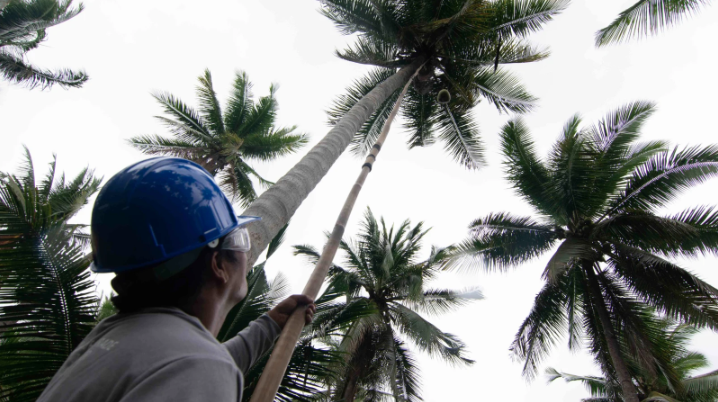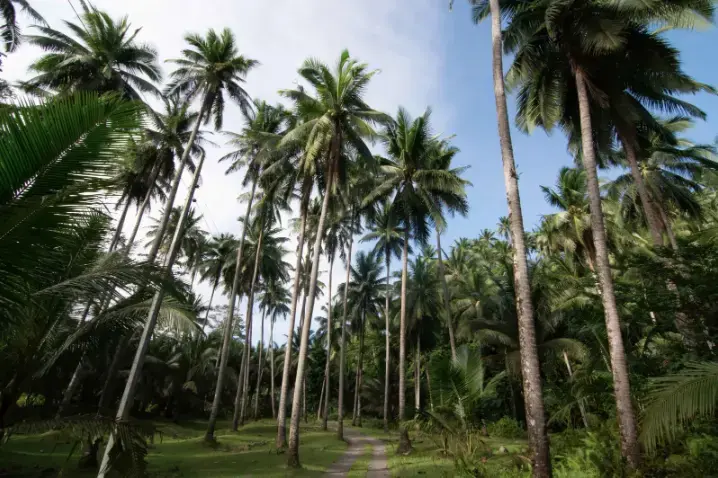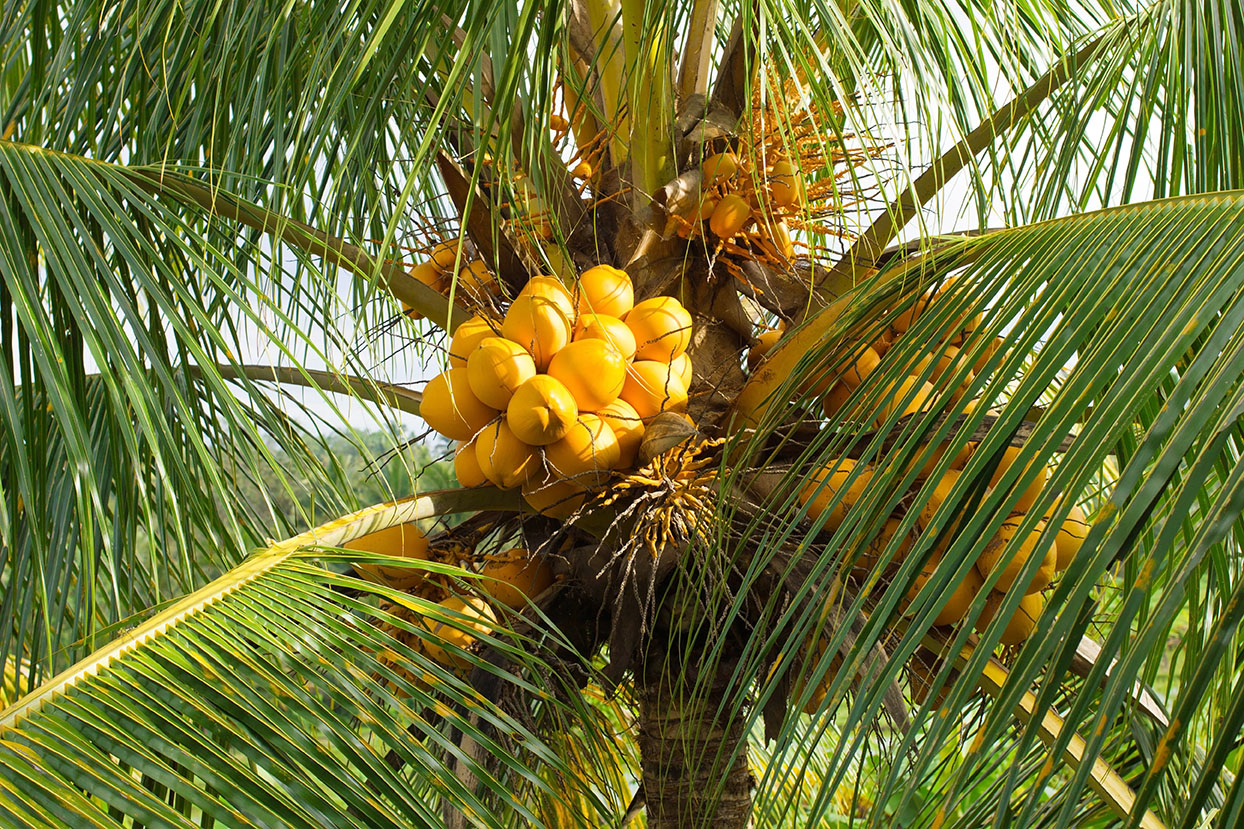
In the Philippines, the coconut tree is called the tree of life due to its many uses and central role in the country’s economy. In Luzon, the most populated island in the country, coconut farms flush with green coconuts can be found on the coast, on top of hills, and in valleys alongside creeks and rivers. The archipelago nation is an ideal place to grow coconuts due to its tropical climate and ample access to water, and it’s now the world’s top producer of coconuts, with an estimated 8.7 million acres being cultivated by more than three million mostly smallholder farmers.
Coconut trees produce a diverse range of products, with oil being the most commonly produced. Though it accounts for 80 percent of coconut products, producers also tap coconuts for water, milk, cream, and even charcoal. Now, there could be a new use on the horizon: biofuel.
“We would like to increase the domestic utilization of coconut, so we’re working with the department of energy to increase our coconut oil biodiesel component to five percent,” Yvonne Agustin, executive director at the United Coconut Association of the Philippines (UCAP), based in the capital Manila, told Earther.
If these plans go forward, they could lead to increased deforestation, especially if more tropical forests are converted into coconut oil plantations for biofuels. The reason for the move dates back to 2018 when there was a global glut of food oils—meaning that palm, coconut, soy, and other oils—faced near-record low prices globally. With the amount that humans can consume in food or cosmetics relatively static, governments and producers have searched for alternative markets or uses.
Agustin said the association was inspired by the paths taken by neighboring Malaysia and Indonesia. In order to grow domestic demand in those countries, the palm oil industry has pushed for mandating an ever-increasing percentage of domestic fuel blends to be mixed with palm oil (20 percent in Malaysia and 30 percent in Indonesia).
From an environmental perspective, palm, coconut, or other tropical food stock-based biofuels are worrying. There is growing evidence that these biofuels have little climate or environmental benefit. In fact, a study funded by the European Commission found that palm oil biofuels have three times the carbon footprint of diesel due primarily to the vast scale of emissions from the destruction of tropical landscapes. Palm oil plantations alone have replaced upwards of 40.6 million acres of tropical rainforests and carbon-rich peatlands globally. Coconut trees are less productive than oil palm in producing oil, meaning that more land will be required to produce the same amount of oil.
It’s not that long ago that palm oil was considered a green alternative to fossil fuels. One of the early drivers of palm oil’s growth in Southeast Asia was a 2003 European Union (EU) mandate that 10 percent of transport fuel mix come from biofuels as part of the region’s greenhouse gas emissions reduction strategy. According to a 2015 EU study, 5.1 million acres of tropical landscapes were converted to palm oil plantations due to Europe’s demand for biofuels.
Once it became clear just how bad palm oil was, advocates became pushing the bloc to change its policy. After years of pressure and a growing body of science showing palm oil wasn’t as sustainable as policymakers thought, the EU finally updated its policies last year. Though the details still need to be ironed out, essentially the use of palm oil from unsustainable sources has to be phased out by 2030, and there is an ongoing effort to push individual countries to move faster.
“We want countries to set a quicker phase-out,” Cristina Mestre, climate and biofuels officer as Transport and Environment, a non-profit based in Brussels, Belgium, told Earther. “2030 is 10 years from now. Countries could actually pass more sustainable measures, sooner.”
Norway was first, banning palm oil procurement starting this year, and France may soon follow. Whether this will make a difference depends not just on the speed of the shift but also what happens to domestic demand in Southeast Asian countries. Any domestic growth there could negate the EU’s decision, meaning little to no benefit for tropical landscapes.
Today, coconut oil is being labeled as a green alternative to replace palm oil. In fact, there is a direct connection between the two crops, and that’s one of the reasons that UCAP and others in the Philippines are pushing coconut oil as a biofuel.
“Because the price of palm oil is very cheap, it has replaced the cooking oil demand for coconut oil,” said Agustin.
The Philippines has been importing greater amounts of cheap palm oil from its neighboring countries, and cost-conscious consumers are choosing it over domestic coconut oil. Lower demand has led to falling coconut oil prices. The solution put forward by large growers and traders? Do as palm oil did, forcing it as a biofuel source under a green banner. There is concern from environmentalists that adding another tropical food crop to the global biofuels mix could result in more tropical land being burned and cleared to produce fuels, not food.

“Anything that can be planted on tropical forest land is a risk because it creates an additional economic incentive for clearing,” Chris Malins, an expert in low carbon and clean fuels policy who runs the consultancy Cerulogy, told Earther. “I would be extremely cautious that any vegetable oil used in the tropics is a good part of a climate change strategy.”
This is the real concern. It is good that more consumers, brands, and entities like the EU are continuing to reduce their use of palm oil for environmental concerns. But if all that happens is that palm oil and coconut is shifted to domestic biofuels, which are then forced upon consumers through government mandates, the end impact could be nil.
“If those full targets are met… it is bound to lead to additional deforestation,” said Malins.
Does this mean all biofuels are bad? Not necessarily.
“We need a much more future oriented approach,” Nils Hermann Ranum the head of Policy and Campaign at Rainforest Foundation Norway, told Earther. “Let’s look at how we can use waste and residues that we know are around us, as the feedstock for fuels, and not crop-based vegetable oils.”
Second-generation biofuels mostly utilize food or animal waste or other non-consumables like algae. If there’s any lesson from the past two decades, it’s that there must be a more thorough, life-cycle analysis done of all the potential impacts before investing in any potential biofuel as a climate solution.
It was a clear mistake to convert millions of hectares of carbon and biodiverse-dense rain forest into monoculture palm oil plantations for biofuels. Europe has learned its lesson. Unfortunately, partly due to business pressure, Indonesia, Malaysia, and the Philippines seems determined to keep giving life to an industry harming the planet, adding another tropical crop to the biofuels mix. If they succeed, global climate goals will only become more difficult to achieve.












